
Sea Surgeon's Dispensatory: 1 2 3 4 5 6 7 8 9 10 11 12 13 14 15 16 17 18 19 20 21 22 23 24 25 Next>>
The Sea Surgeon's Dispensatory, Page 17
Simples: Animals
This section includes all the animal-based medicinal materials which are used without chemical processing. This includes things such as organs, fats and excretions. These are fairly limited in number, probably due to the inability to keep such products from drying out and rotting during the golden age of piracy.
Album Græcum (Dog Feces)
Listed in: Woodall: Album græcum1
Category: Simple - Animal
Humoral Property: dry2; hot3
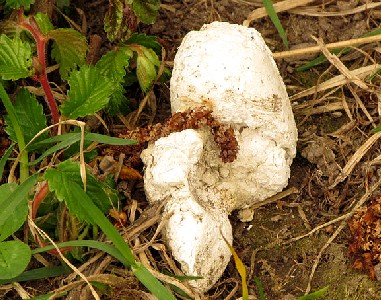
Photo: Frank C. Müller - Album Graecum (White Dog Feces)
Description: "Stercis caninum, sen album græcum, is ...astringent, staieth the laske [looseness of the bowels], cureth the Squinancie [peritonsillar abscess, behind the tonsil], helpeth the Disenteria [dysentery], and driveth away fevers that come by course [menstruation], and is very good to strew the fundament fallen withal [prolapsed anus], for it cureth the slipperinesse thereof, and causeth it being gently put up to stay up, and being mixed and boyled with sallet oyle [sallad oil aka. olive oil] to the thicknesse of an unguent, is very good to cure the painefull Hemorroydes."4
"Album Græcum. This is the white Dung of some Dogs: it is reckon'd to have a detersive [cleansing] Quality, but upon that foot is used only by the common People for sore Throats; it is spread also with Honey in the form of a Plaster, and apply'd outwardly in the like case."5
1 John Woodall, the surgions mate, 1617, p. 122 (incorrectly identified as 130); 2 Thomas Brugis, The Marrow of Physick, 1669, p. 168; 3,4 Woodall, p. 122 (incorrectly identified as 130); 5 John Quincy, Pharmacopoeia Officinalis & Extemporanea, 1719, p. 220
Axungia Cervi (Deer Fat)
Listed in: Woodall-Chest: Axungia Cerui1
Category: Simple - Animal
Humoral Property: hot2

Photo: Jörg Hempel - Red Deer Stag (Cervus Elapus)
Description: Axungia Cervi is the lard of a stag, most likely the red deer which was used to make cornu cervi.
"This Axungia is of a hot nature, doth asswage aches, resolveth [reduces or removes] and mollifieth [softens] hard tumors in any part of the body, and by experience is found very good, administred in Glisters [clysters - enemas] to heale the excoriations [abrasions] of the Intestinum rectum; for it is anodine [soothing] and very sanatine [sanative - healing]. The manner to use it is somewhat touched in some other my instructions elsewhere."3
Although Woodall promises to mention it elsewhere he does not. He does mentions pork lard repeatedly. He also refers to generic 'Axungia' in his discussion of lancets for bloodletting, advising the surgeon's mate to "oile them, or anoint them with Axungie, and so wrappe them in oyly cloutes, that they rust not."4 However, such a use does not seem to justify having a place in the medicine chest for such an unusual substance, so it's purpose is true purpose here is unknown.
1,2,3 John Woodall, the surgions mate, 1617, p. 53; 4 Woodall, p. 27
Axungia Porcina (Pork Lard)
Listed in: Woodall-Chest: Axungia Porcina1
Category: Simple - Animal
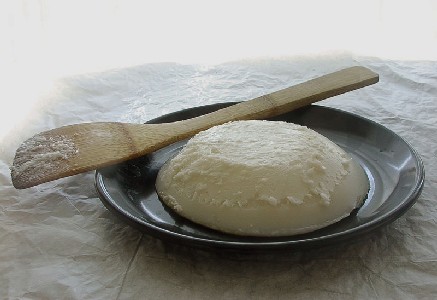
Pork Lard
Description: "Called Axungia of anointing the Axel-tree [of a cart] to make the wheeles turne easier about, for which many use it to this day. It is liquid flowing like oyle with warmth: it hath a lenifying [softening or alleviating] and anodine [soothing] qualitie, and therefore it is not unprofitably used for mitigation [reducing] of sharpe humors, asswaging of paine, healing of burnings with fire, and very fitly mixed with Cataplasmes [plasters] appointed for those effects."2
"Prepared of Hogs-lard. Adeps suillus, axunge [lard of pork]. Composed of 62 parts elain and 38 stearin. Melts at 97°. Insoluable in water and alcohol; but unites with alkalies, and forms soap."3
1 John Woodall, the surgions mate, 1617, p. 52; 2 Woodall, p. 52-3; 3 James Rennie, A New Supplement to the Pharmacopoeias, p. 13
Cantharides (Spanish Fly Wings)
Listed in: Woodall: Cambarides1, Tweedy: Cantharides2
Category: Simple - Animal
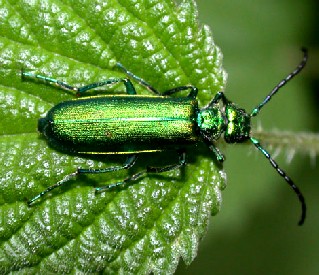
Photo: Franco Christophe - Spanish Fly (\Lytta Vesicatoria)
Description: "Cambarides are used in outward remedies to cause a blister, and sometimes inwardly to move urine: but so they are most dangerous, for they will bring the disease Priapisma [where the male organ will not leave its erect state] upon the Patient in a violent manner, I once knew it given, but it killed the party the third day."3
"Cantharides, Spanish Flies. The external use of these is sufficiently known to all. They raise Blisters by their Pungency and Activity; for stimulating the cutaneous Fibres, they occasion a greater Derivation of Fluids to that part, which passing the Skin, and not being able to penetrate the Cuticle, they divide them and elevate the alter up into a Blister, as has been already hinted ... The Subtilty of these is manifest from their entring into the Blood in such quantities, when only externally apply'd, as are sufficiently felt beyond the Kidneys, and often bring Stranguries [painful urination], and great Heat of Urine. These are sometimes managed so as to open Issues, but it is a painful and uncertain way. The perpetual Blister-Plasters, which are so much advertis'd, are nothing else but the common Epispastick [blistering medicine], dress'd with a mixture in which the Cantharides are finely powder'd and mix'd: therefore those who value themselves upon it as a Secret, either abuse themselves, or other People. By the same management Issues may be provoked to make the greater Discharges, putting the least Particle at the bottom of the Pea, or touching the Pea with an Unguent, with some of them in its Composition."4
1 John Woodall, the surgions mate, 1617, p. 110;2 "158. John Tweedy's Bill for Medicines. November 8, 1743". Privateering and Piracy in the Colonial Period Illustrative Documents, John Franklin Jameson, ed., p. 459; 3 Woodall, p. 120; 4 John Quincy, Pharmacopoeia Officinalis & Extemporanea, 1719, p. 221
Cera Alba (White Beeswax)
Listed in: Moyle:Ceræ alb.1
Category: Compound - Ointments
Photo: Maša Sinreih - White Wax (Cera Alba)
Humoral Property: "mean betwixt heat and cold, humidity and siccicity [dryness]"2
Description: "White-wax is prepared from the yellow, but reducing it to thin flakes, and exposing it for a length of time to the air; when sufficiently bleached, it is melted, and cast into cakes. The best sort is of a clear and almost transparent whiteness, a light agreeable smell like that of the yellow wax, but much weaker.
The chief medical use of wax is in cerates, plasters, unguents &c. [etc.]"3
"All Wax mollifies [softens], califies [heats]... and moderately expletes [completes] the body. It is good in broth for such as have the bloody flux. That is may be dealbated, it must be melted at the fire, then demerged in pure Fountain-water, where it must be stirred and expurged."4
1 John Moyle, The Sea Chirurgeon, 1693, p. 35; 2 Jean de Renou, A Medicinal Dispensatory, 1657, p. 393; 3 John Quincy, Pharmacopoeia Officinalis & Extemporanea, 1782, p. 204; 4 Renou, p. 393
Cera Citrina (Yellow Beeswax)
Listed in: Woodall: Cera Citrina1
Category: Simple - Animal
Humoral Property: hot2; "heate[s], moystneth temperately"3
Photo: Mauro Cateb - Yellow Beeswax
Description: "Cera citrine, or yellow waxe, doth mollifie [soften] ...it is good for to amend the milke in the nurse coagulated, it swageth [assuages] payne, healeth wounds and ulcers, and hath commonly a place in all good unguents and plasters, it is a good medicine to drunke or eaten, and so swallowed, downe for to cure the exulcerations [soreness] of the stomacke or intrailes in fluxes, where inward exulcerations are to be feared."4
"Wax softens, heats & meanly filles sores with flesh, it suffers not the milk to Curdle in Womens breasts; inwardly it is Given (ten grains at a time) against bloody Fluxes."5
“Wax ...appears to be a certain Species of Turpentine, which the fat Juices of Plants, when heated by the Sun, sweat out upon the Surface, or produce within the Cavities of the flowery Tufts. This the Bees collect, roll up into little Balls, and carry between their hind Feet to their Hives, where it is wrought into the Cells of their Combs; and from hence, after the Honey is separated from the drossy [impure] Parts, it is procur'd for human Uses. It is generally yellow, and not ungrateful either in Taste or Smell. It becomes hard, and almost brittle, in the Cold, but grows soft, and dissolves with Heat. Wax is heating, mollifying [softening], and moderately incarnating [generates flesh in wounds]."6
1 John Woodall, the surgions mate, 1617, p. 108; 2 Nicholas Culpeper, Pharmacopœia Londinesis, 1720, p. 47; 3 Woodall, p. 108; 4 Woodall, p. 108-9; 5 Culpeper,p. 47-8; 6 Robert James, Pharmacopoeia Universalis, 1747, p. 483
Concha (Powdered Shellfish)
Listed in: Tweedy: Conch. praept.1
Category: Simple - Animal
Humoral Property: dry2
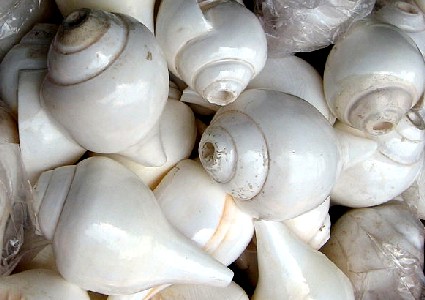
Photo: Deepak Amembal - Conch Shells
Description: "Concha, Offic. Shell Fish. This is a general Name comprehending a great many sorts of Shell Fish. The Shells of these Fish in general, are drying absorbent, correcting [able to correct "bad" bodily humors, although in what specific way is not clear from the text], and precipitating [able to settle solid particles]; for which Purposes, those beat to a fine Powder are Preferable to those levigated [reduced to paste] on a Marble with Water, which are commonly called Concha Preparata. What are usually kept in the [apothecary] Shops, under this Title, are the Shells of Muscles, and are recommended for exciting a Diaphoresis [causing the patient to sweat, to elminate corrupt humors] in Intermitting Fevers [usually malarial fevers], if a Scruple, or half a Dram is exhibited, about an Hour before the Paroxysm, in Carduus Water, or that of the lesser Centaury; ordering the Patient, at the same time, to be kept warm, in order to encourage a Disphoresis. But, when the Shells are calcined [roasted], they become Lime, and do not absorb and correct [the bodily humors], but stimulate and resolve [separate them], in Consequence of the Acrimony they have acquired by Calcination. In this Case they are so far from correcting the Acrimony of the Juices, that they rather increase the Heat of the Stomach and Fauces [arched opening at the back of the mouth]."3
1 "158. John Tweedy's Bill for Medicines. November 8, 1743". Privateering and Piracy in the Colonial Period Illustrative Documents, John Franklin Jameson, ed., p. 459; 2,3 Robert James, Pharmacopoeia Universalis, 1747, p. 504
Corallium Rubrum (Red Coral)
Listed in: Tweedy: Coral. rubr. praept.1
Category: Simple - Animal
Humoral Property: dry and cold2; cools [refrigerates] and dries3; "it is drying and refrigerating"4
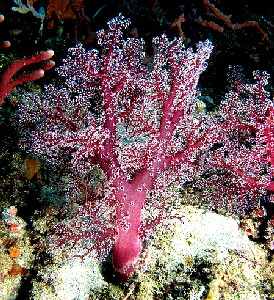
Photo: Nick Hobgood - Red Coral (Dendronephthya)
Description: "Corall... binds, purifies the blood [one of the bodily humors], &c. [etc.]"5
"Corralium rubrum... Red Coral. It grows in the Sea, and is found with the White, than which is more used. It is ...astringent [draws the body's tissues together], sweetens the Blood [improves its humoral qualities], frees the Stomach from acid Juices, greatly strengthens the Liver, and stops all Fluxes."6
"Corralium rubrum, Red Coral. There are also other Colours, but this is chiefly used in the [apothecary] Shops. Some Naturalists tell us, it grows at the bottom of the Sea like a Plant or Shrub, and that it is not so hard as we have it, until it is gather'd, and brought up into the Air. The brighter and higher the Colour, it is accounted the better. Pliny [First century Roman author and naturalist Gaius Plinius Secundus or Pliny the Elder] speaks of it as found only in the Indian Seas, but we have it now from many parts of the Mediterranean, and Naples is a great Market for it. This also by its extraordinary Hardness carries along with it some part of the levigating Stone [stone used to grind substances into powder]. It is a very good Astringent, and given with good success in Diarrhea's, and Defluxions of all kinds. It is likewise accounted a great Sweetner, and therefore with good reason prescribed to correct the Acidities in the Stomachs of young Children: by which it very probably has obtain'd the Reputation of being good against Fits, and easing the Teeth in cutting."7
1 "158. John Tweedy's Bill for Medicines. November 8, 1743". Privateering and Piracy in the Colonial Period Illustrative Documents, John Franklin Jameson, ed., p. 459; 2 Thomas Brugis, The Marrow of Physick, 1669, p. 169 & Nicholas Culpeper, Pharmacopœia Londinesis, 1720, p. 48; 3 Jean de Renou, A Medicinal Dispensatory, 1657, p. 407 (second page 407 in mispaginated sequence); 4 Robert James, Pharmacopoeia Universalis, 1747, p. 300; 5 Brugis, p. 169; 6 James, p. 300; 7 John Quincy, Pharmacopoeia Officinalis & Extemporanea, 1719, p. 108
Cornu Cervi (Hartshorn)
Listed in: Woodall: Cornu cerni1, Moyle: Corn. Cerv. Rasp.2, Tweedy: Ras. Corn. Cerv.3
Category: Simple - Animal

Photo: Mehmet Karatay
Red Deer Stag, Source of Hartshorn
Description: "Harts horne is to be numbred among Cordiall simples [those good for the heart]in the highest place, it is given in want of Unicornes horne4 and not unfitly, it comforteth the heart, is good against poyson, provoketh urine, openeth obstructions, easeth the chollicke, disperseth winde, killeth wormes in the body, is good against paines of the reines [kidneys], or bladder, and being taken upon each occasion in liquors [liquids] proper to the former griefes, it is much the better in force: Thus much is ment of Harts horne unburned. And being burned the pouder thereof is very good against the bloudy, or any other fluxes of the belly."5
"Harts' horns are the horns of the male red deer. Various substances were made from the shavings of the animals' horns."6
“The Virtues of Harts-horn are the same with Unicorns horn.
[resists Poyson, and the Pestilence, provokes Urine, restores lost strength, brings forth both birth and Afterbirth.]"7
1 John Woodall, the surgions mate, 1617, p. 95; 2 John Moyle, The Sea Chirurgeon, 1693, p. 33; 3 "158. John Tweedy's Bill for Medicines. November 8, 1743". Privateering and Piracy in the Colonial Period Illustrative Documents, John Franklin Jameson, ed., p. 460; 6 Yes, the mythical unicorn's horn was still being sold in medicine shops in the 17th and 18th centuries. "The beast that produced the unicorn horns, sold dearly in apothecary shops until the end of the eighteenth century, was none other than the Narval, Monodon monoceros, a harmless whale living off Greenland." (From Mireille Didrit and Raymond Pujol, "Note de recherche d'Ethnozoologie: Licorne de Mer ou Licorne de Terre: le Narval" (Translated from French by the author), September 1996, Gathered 6/13/15); 5 Woodall, p. 95; 6 Hartshorn, Wikipedia, gathered 11/2/14; 7 Nicholas Culpeper, Pharmacopœia Londinesis, 1720, p. 46
Icthyocolla
Listed in: Moyle: Ictheocalla , p. 331
Category: Simple - Animal
Humoral Property: dry2
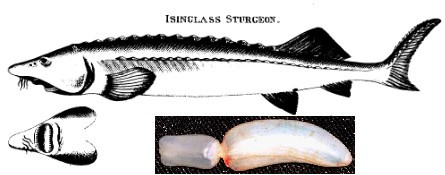
Isinglass Sturgeon and Swim Bladder From Which Isinglass is Harvested3, From Zoology,
Vol
5, By George Shaw and James Francis Stephens (1804); Bladder
Photo: Uwe Gille
Description: "Icthyocollæ, Isinglass. Schroder [17th Century German Physician and Pharmacologist Johann Schröder] says, it is from a Fish which is common in the Danube. It has not Bones, but about the head. After 'tis cut into small pieces, they boil it in Water to a thick Jelly, which is spread abroad and dry'd, then roll'd up and brought to us in the form we see it in the [apothecary] Shops.3 It is of a very glutinous [sticky] Quality, and consequently good in all Disorders which arise from too thin and sharp a State of Fluids."4
"Icthyocolla, Offic. The Isinglass Fish. The Glue of this Fish, commonly called Isinglass, is used, and is of a yellowish Substance, made up in a spiral Form, of a glutinous Consistence, and of no Smell. It is prepared of the Skin, Intestines, Stomach, Fins and Tail of this Fish in the following Manner. These Parts of the Fish, when cut in small Pieces, are macerated [soaked] in a sufficient Quantity of Water: Then they are boiled over a slow Fire, to the Consistence of a Poultice; after which they are to be moisten'd, and spread into Pellicules [a film], before they become cold, and reduced to a hard Mass.3 This Substance, according to Shroder is of a drying, incarning [creates flesh in wounds], and, in some Measure, of an emollient [softening] Quality; it inspissates [thickens] the Blood, and is of an anodyne [pain-killing] Nature: It is used in Exulcerations [soreness] of the Lungs and Fauces [the arched opening at the back of the mouth], and in a Fluor Albus [discharge from the vagina] it is exhibited with Success: Some also prescribe it in Dysenteries. It is of a conglutining [adhesive] Nature, when externally applied."5
1 John Moyle, The Sea Chirurgeon, 1693, p. 33; 2 Robert James, Pharmacopoeia Universalis, 1747, p. 513; 3 Today isinglass is actually gotten from the swim bladder of the fish. It is not clear whether this method was actually used during the golden age of piracy or not, since neither of the authors who cite it here have first hand information. 4 John Pechey, The Compleat Herbal of Physical Plants, 1707, p. 97;5 James, p. 513
Ivory
Listed in: Woodall: Dentes Elephantini1
Category: Simple - Animal
Humoral Property: "cools and dries moderately" 2
_Bernard_Dupont.jpg)
Photo: Bernard Dupont - African Elephant with Tusks
Description: "Dent Elephantins, or Elephants tooth hath an astringent force [contracts the body's tissues], healeth felons [paronychia - foot rot], and is good for white fluxes of women [vaginal discharges], the Icteritia Flava or the yellow Jaundise, Morbus Regins [syphilis], wormes, and continuall obstructions."3
"This animal is very rare, strong, calm and docile. Only the teeth are used, commonly called ivory.
Ivory is astringent, strengthens the bowels, stops the whites of women from flowing. It is appropriate in Jaundice, drives out worms, drives away prolonged obstructions, stomach pains and weakness. Cures Epilepsy, prevents melancholy [black bile, one of the bodily humors], resists corruption and poisons. Its filings are used in infusions, and the powder in a substance that is exhibited.
{Dose: 1/2 dram}"4
1 John Woodall, the surgions mate, 1617, p. 59; 2 Johannes Schroder, Pharmacopoeia medico-chymica, 1677, translated out of Latin by the author, p. 315; 3 Woodall, p. 59; 4 Schroder, p. 315
Mel Simplex (Honey)
Listed in: Woodall: Mel simplex1, Tweedy: Mel Commun.2
Category: Simple - Animal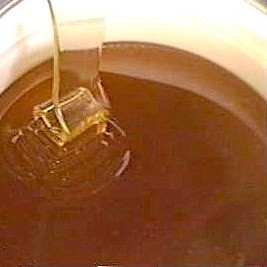
Photo: Emmanuel Boutet - Honey
Description: "English hony being yellow, the sapour [flavor] and odour pleasant, being sharpe, pure, sincere, cleare, fast or stiffe, yeelding little spume [foam or froth] in decocting [boiling], is good and very profitable for those that are costique [caustic - referring to burning, probably in the stomach], good for the stomacke if one drinke it with water: it helpeth the bladder & reynes kidneys]: it is good for the eyes: it mundifieth [cleanses], openeth, and healeth: and for burnings and scaldings it healeth them without scar, and is very good to heale ulcers of the eares: and (saith [French physician Pedanius] Dioscorides) drunke with water is wholesome for the belly and stomacke: and also for such as are pained in the kidneys and bladder, it helpeth them. It is also good to be anointed in the eyes to cleare the dimnesse of light in them: it hath an abstergent or clensing force: it openeth the mouthes of veynes, whereby it also draweth."3
"Honey is of a gallant cleansing quality, exceeding profitable in all inward Ulcers in what part of the body soever, it opens the veins, cleanseth the Reins [kidneys] and Bladder... I know of no vices belonging to it, but only it is soon converted into Choler [black bile, one of the bodily humors]."4
"In our Country [England] Hampshire Honey has the greatest name, but I cannot say, whether for its greater Excellency, or the Quantity which that Country affords. That which is whitest and hardest is most prefer'd, but the browner and smoother sort is best in Medicine, because it is not so apt to cand [crystallize], which deforms and spoipls it"5.
1 John Woodall, the surgions mate, 1617, p. 53; 2 "158. John Tweedy's Bill for Medicines. November 8, 1743". Privateering and Piracy in the Colonial Period Illustrative Documents, John Franklin Jameson, ed., p. 457; 3 Woodall, p. 53; 4 Nicholas Culpeper, Pharmacopœia Londinesis, 1720, p. 47; 5 John Quincy, Pharmacopoeia Officinalis & Extemporanea, 1719, p. 226
Mummia (Mummy)
Listed in: Woodall-Chest: Mummia1
Category: Simple - Animal
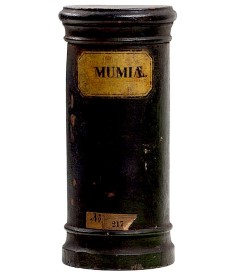
Photo: Christoph Braun
Mummia -
From Museum für Hamburgische Geschichte
Description: "Mummia is astringent [draws flesh together], helpeth fluxes [flows] of bloud, the bladder ulcerated, and the inward distempers of the yard [penis]: as also it provoketh urine, and is very good to bee drunke in powder against great contusions or coagulated bloud within the body."2
"Under the name of Mummy are comprehended, first, the Mummy of Arabians, which is a Liquament, or concreted Liquor, obtain'd in the Sepulchres, by Exudation [oozing] from Carcases embalm'd with Aloes, Myrrh, and Balsam. If this Mummy could be procured right and genuine, it would be preferable to the other Sorts. The second Kind of Mummy is the Egyptian, which is a Liquament [liquid mixture] of Carcases, season'd with Pissasphaltus [earth-pitch: a kind of soft bitumen]. A third Substance, which goes by the name of Mummy, is a Carcase [carcass] terrified [torrefied - roasted] under the Sand, by the Heat of the Sun: but such a one is seldom to be met with in our Country"3
"Mumia, Mummy. This is the Flesh of Carcasses which have been embalm'd. But although it yet retains a Place in Medicinal Catalogues, it is quite out of use in Prescription."4
1,2 John Woodall, the surgions mate, 1617, p. 109; 3 Robert James, Pharmacopoeia Universalis, 1747, p. 512;4 John Quincy, Pharmacopoeia Officinalis & Extemporanea, 1719, p. 148
Oculi Cancrorum (Crab's Eyes)
Listed in: Tweedy: Ocul. cancr. praept.1
Category: Simple - Animal
Humoral Property: dry2
Photo: H. Zell - European Crayfish (Astacus astacus), Source of Crab's Eyes
Description: "Oculi Cancrorum, Crabs Eyes. These are much in use both in the [apothecary] Shop-Medicines, and extemperoraneous Prescriptions [from the Latin 'ex tempore'("at the time") - a prescription written on the spot for a specific patient with a specific ailment], as indeed are most of the same Tribe. They are not only accounted absorbent and drying, but also discussive [dispersing], and good for the [kidney] stone."3
"Astacus fluviatilis... The Crafish, or Crevis. They are found in Rivers, and the Parts of them used are the Flesh, and what we call the Lapilli, or Oculi Cancrorum, known by the Name of Crab's Eyes. In their Head, according to some, or rather in their Stomach, are found two white Stones, as large as a Pea, of a Kind of lenticular or orbicular Form, but compress'd, and somewhat hollow on one Side; whereas the other is convex, and dispos'd in Lanimæ [layers]. These Stones are of an earthy Taste."4
"Crab's eyes - masses of calcareous matter found, at certain seasons of the year, on either side of the stomach of the European crawfishes, and formerly used in medicine for absorbent and antacid purposes; the gastroliths."5
1 "158. John Tweedy's Bill for Medicines. November 8, 1743". Privateering and Piracy in the Colonial Period Illustrative Documents, John Franklin Jameson, ed., p. 459; 2,3 Robert James, Pharmacopoeia Universalis, 1747, p. 485; 4 John Quincy, Pharmacopoeia Officinalis & Extemporanea, 1719, p. 105;5 "Crab's eyes", the freedictionary.com, gathered 6/13/15
Sperma Ceti
Listed in: Woodall-Chest: Sperma Cati.1, Moyle: Sperm. Cœti2
Category: Simple - Animal
Humoral Property: moist3; "of a colde faculty"4
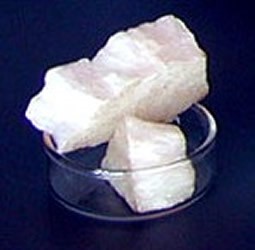
Spermaceti Wax
Description: "Sperma Cati, or Spuma maris, or the spawne of the whale is sowre in taste, spungy and white in the shew, unsavoury in smell, and waighty, having a sharpe quality, it ...clenseth, and digesteth [encourages the formation of new flesh in a wound], and is sometimes used of women, to cleare the skinne from spots and morphew [skin blemishes], and it is good also against bruises inwardly, taken with ...Mummia, and also outwardly warme, to annoynt the parts contused therewith"5.
"Sperma Ceti. This is agreed on all Hands to be the Product of the Cetus, Offic. or the Parma-fitty Whale. [French physician Pierre] Pomet positively affirms that Sperma Ceti is the Brain of a Sort of Whale called Byaris, and, by the People of St. John de Luz, Cachalot, and he also affirms, that he has not only seen it prepar'd, but has often prepar'd it himself. ...Those who prepare it, taken the Brain as aforesaid, and melt it over a gentle Fire; then they cast it into Moulds, like those wherein they refine Sugar; and after it is cold, and drain'd from the Oil, they take and melt it again, and proceed after the same Manner, till such time
as it is well purified, and very white; then with a Knife, made for the Purpose, they cut it into
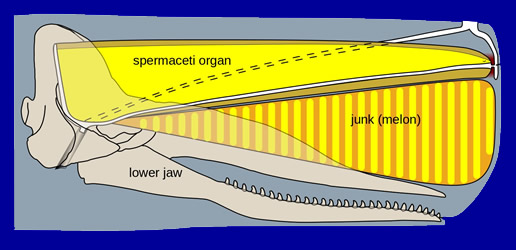
Artist: Wiki User Kurzon - Spermaceti Organ Diagram - Spermaceti Comes From the Head of Sperm Whales
Scales or Flakes, just so as it appear when brought to us. ...but I have seen Sperma Ceti which has undergone no treatment at all, except being put into Paper Bags, so that the OIl which adheres to it, may be absorb'd. the true Sperma Ceti is very white, and is in very small Flakes, not much larger than the Crystals of Tartar: It dissolves by rubbing upon the Hand into a sort of Oil; and does not adhere to the Palate when chew'd, as the common Sort will... It is a noble Medicine in many Cases, tho' principally used in Bruises, inward Hurts, and after Delivery. It is an excellent Balasmic in many Distempers of the Breast; and gently deterges [cleanses] and heals. In Coughs, from sharp Rheums [running flow from the nose], Erosions and Ulcerations, it is very safe, pleasant and effectual; as also in Pleurisies [tuberculosis], and inward Imposthumations. Where the Mucus of the Bowels has been abraded [worn away] by Acrimony and Choler [yellow bile, one of the bodily humors], as in Diarrhæas, and Dysenteries, this is a very good Healer. In Ulcerations of the Kidneys, and bloody Urine, it is likewise a very suitable Medicine; and, by softening and relaxing the Fibres, it contributes frequently to Expulsion of Gravel [from the kidneys], by enlarging the Passages."6
1 John Woodall, the surgions mate, 1617, p. 109; 2 John Moyle, The Sea Chirurgeon, 1693, p. 33; 3 Thomas Brugis, The Marrow of Physick, 1669, p. 169; 4,5 Woodall, p. 109; 6 Robert James, Pharmacopoeia Universalis, 1747, p. 530
Simples: Minerals
This last category of simples are minerals - materials are mined from the earth, including earth itself.
Ærugo (Verdigris)
Listed in: Woodall: Æs Viride1
Category: Simple - Mineral
Verdigris
Description: "Æs Viride, or verdigrece, hath a sharpe quality, digesting [encourages formation of new flesh], attracting, extenuating [reduces the strength of things], corroding & abstersive [cleansing or purging] stoppeth fretting and spreading sores, and easeth the callous hard flesh of fistulaes [fistulas], good in ulcers and Ophthalmies of the eyes, it is the rust of copper or brasse either."2
"This Verdegrease is not the flower [flour - dust] of Brass, as some think, but a certain green rasure [scraping], which exudes out of its plates wet with vinegar. ...the vulgar [common type] is copious, and every-where venale [available for purchase], which may be made many wayes, but most usually thus:
Some sharp Vinegar must be infused into a Hogshead [a large cask], or other ample vessel; whereon a brazen [brass] vessel must be inversely superimposed; if it may be, a concamerated [arched] one; or if it be plain, it must be so obstructed, that there may not be any spiracle [opening] left: after ten dayes, let the cover be removed, and the Verdegrease thereon eraded [scraped off]....
It is sharp, digestive, and attractive: it discusses not onely tender, but hard flesh; and it is not onely mordacious [caustic] to the gust [taste], but to the very Ulcers. If you adde a little of it to a large Searcloth [cerecloth - cloth treated with wax], the mixture will exterge [eliminate] without mordacity. Many erre in ascribing a Sarcotical [uniting] or Epulotical [wound healing] faculty to many Medicaments, when they are of themselves are not, but become such by composition [adding them to compound medicines]."3
1,2 John Woodall, the surgions mate, 1617, p. 114; 3 Jean de Renou, A Medicinal Dispensatory, 1657, pp. 429-30
Alumen (Alum)
Listed in: Woodall: Alumen1, Tweedy: Alum. Crud.2
Category: Simple - Mineral
Humoral Property: dry3; hot4
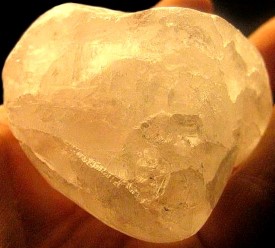
Alum
Description: "Alumen, or Allum, is astringent and yet purging, mendeth putriefied ulcers, drieth the moyst, consumeth proud superfluous flesh [unwanted granualated flesh growing in a wound], taketh away the itch, and cureth the scab, and is very profitable in lotions for ulcerations of the mouth, throat, or else-where."5
"Allum heats, binds and purgeth; scours filthy Ulcers, and fastens loose Teeth."6
“Alumen. Alum. There are three Sorts of Alum principally used, as the Alulumen rupenum, Offic. Alumen Rupcum sive Chyrstallinum, Ind. Med. Alumen factitium, Mer. Pin. Common Alum. This, together with the Method of making it, from the calcin’d Stone, Kali [kalinite - hydrated potassium aluminium sulfate], and Urine, are so well known, that they require no farther Notice. It is esteem’d drying, astringent [draws the flesh together], and incrassating [makes liquids thicker]. …
The second Sort of Alum, is the Alumen Rachi Gallis, Offic. Alumen Romanum sive rubrum, Ind. Med. Roch Alum. It is somewhat like common Alum, except that it is of a palish red. It is imported from Italy and Smyrna, and is said to be made like other alum, but without the help of Kali and Urine. It agrees in Virtues with the preceeding."7
1 John Woodall, the surgions mate, 1617, p. 112; 2 "158. John Tweedy's Bill for Medicines. November 8, 1743". Privateering and Piracy in the Colonial Period Illustrative Documents, John Franklin Jameson, ed., p. 460; 3 Thomas Brugis, The Marrow of Physick, 1669, p. 160; 4 Nicholas Culpeper, Pharmacopœia Londinesis, 1720, p. 46; 5 Woodall, p. 112; 6 Culpeper, p. 46; 7 Robert James, Pharmacopoeia Universalis, 1747, p. 537-8
Argentum Vivum (Quicksilver, Mercury)
Listed in: Woodall-Chest: Argentum vinum.1, Moyle: Argent. Vivum2, Tweedy: Argent. Viv.3
Category: Simple - Mineral
Humoral Property: "never madefies [moistens], often refrigerates [cools], often califies [heats] ...Its qualities are as yet under debate; for some from its effects say, it is hot, others cold"4
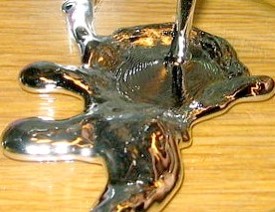
Quicksilver - Mercury
Description:"Argentum vinum doth corrode, killeth the itch & lice, woundeth the intestines, suppresseth urine, swelleth the body, hurts the stomacke and belly, resolveth [removes], penetrateth and purgeth."5
"Mercurius. Mercury, or Quicksilver. This is a fluid, metallic Substance, cold to the Touch, or a shining Silver Colour, very heavy, volatile, and which will unite with most Metals, especially Gold, to which it joins itself very closely. It is sometimes found in its fluid Form in the Bowels of the Earth; and in that Case, it is first well washed with Water, to clear it from the Earth; then sometimes with Vinegar and Salt, to carry off all other metallic Parts; and lastly it is passed thro' Cotton, or dress'd Leather and then has the Name of Virgin Mercury. It is also found in Glebes [soil], or in Form of a red suphureous Mercurial Mineral, called Cinnebar, or
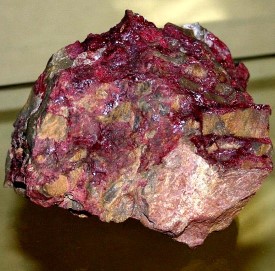
Photo: Chris Ralph - Cinnabar
of a stony Glebe, sometimes red, sometime yellow, sometimes dark, and sometimes of a Lead Colour. It was by the Antients [ancient physicians] rank'd among Poisons.... By injudicious Use of it, whether outwardly applied, or inwardly taken the Nerves are likewise affected, weaken'd, corrupted, and contracted; whence Tremblings, Spasms, Palsies, and too great an Attenuation [reduction] of the Fluids, which often brings on a fatal Salivation, Ulcers in the Mouth and Throat, and incurable Loosenesses [of the bowels]. Quicksilver judiciously administer'd, is, however, undoubtedly a most excellent Medicine; it opens the Pores, small Vessels, and Ducts of the Glands, resolves [eliminates] obstructed Humours, attenuates [reduces] those which are too thick, viscid [adhesive], especially the Lymphæ; and dissipates Concretions, even in the remotest Parts of the Body. On all these Accounts it is found to be of singular Service in Tumours, swell'd Glands, a schirrhous [hardened] Spleen, Mesentery [a fold of tissue that attaches organs to the body wall], or Liver, Ganglions [cysts, usually found at the joints], Strumæ [swollen thyroid in the neck], and other such Diseases. It also blunts the Acrimony of the Fluids, and hence performs Wonders in Venereal Tumors, Buboes [swellings found near the groin], and Ulcers, in cutaneous Pustules, Scabs, and other Affections of the Skin"6.
1 John Woodall, the surgions mate, 1617, p. 114; 2 John Moyle, The Sea Chirurgeon, 1693, p. 33; 3 "158. John Tweedy's Bill for Medicines. November 8, 1743". Privateering and Piracy in the Colonial Period Illustrative Documents, John Franklin Jameson, ed., p. 459; 4 Jean de Renou, A Medicinal Dispensatory, 1657, p. 409 (mispaginate - second 409 in book); 5 Woodall, p. 114; 6 Robert James, Pharmacopoeia Universalis, 1747, p. 572-3
Arsenicum (Arsenic)
Listed in: Woodall: Arsenicum1
Category: Simple - Mineral
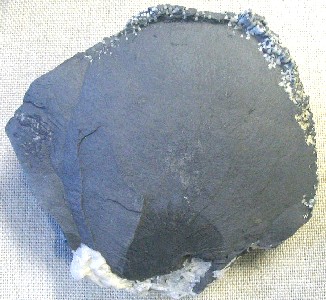
Photo: Aram Dulyan - Naturally Occuring Arsenic
Description: "White and yellow Arsenicum, called arsenicum album & Citrinum, are enemies to the life of man or beast taken into the body, this minerall killeth any living creature, and is of corroding quality, outwardly applied, it causeth a hard crusted scab with vehement burning, eateth away superfluous flesh, & taketh away haires. It cureth the morphew [a skin blemish], the skinne annointed with water of the infusion thereof."6
"Arsenicum, Arsenick. This is a ponderous heavy] Mineral, consisting of a Sulphur loaded with corrosive Salts. There are three sorts; the Yellow, call'd Orpiment, much known amongst the Painters; Red, call'd Sandarath; and the White, which is most properly call'd Arsenick. It is made of the Red by mixing equal parts of Sandarach and common Salt, and subliming them together.
We meet with many Preparations of this in Chymical Writers; but they all turn upon this, by frequent Sublimations and Ablutions to blunt so far the Salts, as to change them from a Poison into a Medicine of Safety; after the manner of White Sublimate. But the advantage by procur'd does not seem to be worth the pains, because we are better and more easily furnish'd from the Mercurial Preparations for the same Intentions, as these are pretended for. And as they are likewise neither in the [apothecary] Shops, nor ever taken notice of in Prescription, they are not worth room here."8
1,2 John Woodall, the surgions mate, 1617, p. 114; 3 John Quincy, Pharmacopoeia Officinalis & Extemporanea, 1719, p. 289-90
Bolus Armenus (Armenian Bole)
Listed in: Woodall-Chest: Bolus verus.1, Moyle: Bol. Ver.2
Category: Simple - Mineral
Humoral Property: "very dry"3
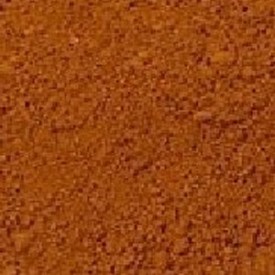
Armenian Bole
Description: "Bolus Armena vel Orientalis verus is ... astringent [draws together], it is a good medicine in resisting the fluxes [flow] of blood, helping the Catarrhe [catarrh - excessive build-up of mucus in the nose and throat], Dissentary [dysentery] and ulcers of the mouth, and prevailing against pestilence, all other like infections."4
"Bolus Armenus, Bole Armonick. This is a natural Earth, and brought chiefly from Armenia, whence it takes its Distinction, tho improperly express’d in English. Some conjecture that it has some small mixture of Iron in its Composition. That which is of a palish, red, soft, and fatish upon the Palate, and strongly adheres to the Tongue, is the best: for it is very much adulterated in the [apothecary] Shops, or at least a great deal is brought there good for little. It is both Astringent [contracts the body's tissues], and a Vulnerary [heals wounds]: and therefore with very great reason frequently found in the [apothecary] Shop-Medicines, and often prescribed for Diarrhea's, Dysenteries, Hemorrhages, Catarrhs, and all kinds of Defluxions and inward Injuries. It is likewise much used outwardly in strengthning Plasters, and Luxations [dislocations] of the Joints."5
1 John Woodall, the surgions mate, 1617, p. 111; 2 John Moyle, The Sea Chirurgeon, 1693, p. 32; 3,4 Woodall, p. 111; 5John Quincy, Pharmacopoeia Officinalis & Extemporanea, 1719, p. 106-7
Bolus Bohemica (German Bole)
Listed in: Woodall: Bolus Communis1
Category: Simple - Mineral
Humoral Property: "very dry"2
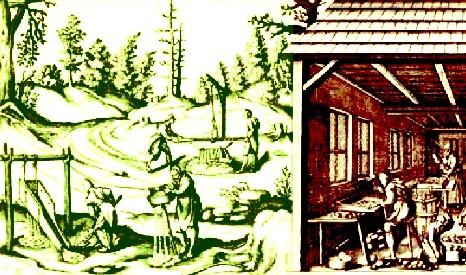
Mining in Germany, From Bericht Vom Bergwerck, by Georg Engelhard Löhneysen (1660)
Description: "Bolus communis, common Bole hath the same effect as the former Bolus [Bolus Armenus]."3
Of Bolus Armenus, Woodall says it is "astringent [draws together], it is a good medicine in resisting the fluxes [flow] of blood, helping the Catarrhe [catarrh - excessive build-up of mucus in the nose and throat], Dissentary [dysentery] and ulcers of the mouth, and prevailing against pestilence, all other like infections."4
"Bolus Bohemica, Offic. German Bole. It is an earthy Substance, of the same Colour with Bole Armoniac, but somewhat fainter. It has some Veins of a yellowish Colour running thro' it, and is heavy, easily friable [crumbles], and of an astringent Taste. It is dig'd from the Mines of Bohemia, and thence imported to us. It agrees in Virtues with Bole Armoniac, and is sometimes kept in our Shops. Aldrovandus [16th century Italian naturalist Ulisse Aldrovandi] informs us, that it is a very efficacious Medicine in all exanthematous [scarlet] Fevers."5
1 John Woodall, the surgions mate, 1617, p. 111; 2,3,4 Woodall, p. 111; 5 Robert James, Pharmacopoeia Universalis, 1747, p. 548
Calx Viva (Quicklime)
Listed in: Woodall: Calx viva.1 Moyle: Cinabrium2
Category: Simple - Mineral
Photo: Wiki User ChemicalInterest - Quicklime (Calcium Carbonate)
Description: "Quick-lime, burns to a crust; the washed, dries without mordacity [biting], is good in contumacious [resistant to healing] ulcers, &c. [etc.]"3
"Calx, Offic Lime. Quick Lime... is no more than a calcarious [calcium carbonate] Stone, burn'd into a Calx of a white cineritious [white-grey] Colour, of an acrid and pungent Taste, and which, when it has not been too long exposed to the Air, produces and Effervescence, Smoak, and a considerable Degree of Heat, when Water is poured upon it; but when it is penetrated by moist and humid Parts of the Air, it ceases to produce an Effervescence, and becomes a kind of Powder. Quick-Lime may be prepar'd not only of the Stone commonly called the Lime Stone, but also of Marble, and other Stones of a close Contexture, and hard Nature....
Quick lime is sometimes used by Surgeons as an Escharotic [mild caustic, or potential cautery], but taken internally it is esteem'd a Poison."4
1 John Woodall, the surgions mate, 1639, p. 83;
2 John Moyle, The Sea Chirurgeon, 1693, p. 32; 3 Thomas Brugis, The Marrow of Physick, 1669, p. 170; 4 Robert James, Pharmacopoeia Universalis, 1747, p. 551
Cinnabar
Listed in: Woodall-Chest: Calcanth. Rubif.1
Category: Simple - Mineral
Humoral Property: hot2

Photo: Chris Ralph - Red Cinnebar
Description:"Cinabaris is astringent [draws together], hot, extenuating [reduces strength of], and hath the vertue or vices of Mercurius [mercury] or Argentum vinum [quicksilver]. It is of two kindes, either native which few know, or artificiall, and then it is compounded of Quick-silver and Brimstone, and so it that we buy in the [apothecary] shops."3
"Cinnabaris nativa, Offic. Native Cinnabar. This Cinnabar is a Fossil [mineral], metallic, heavy Substance, not very hard, found sometimes mix'd with Stones. Of the pure Cinnabar there are several Kinds; of a purple Colour, inclining to red, but which, by grinding, turns to a very beautfiful Red; another of a blackish or liver Colour... and a third of a yellowish Colour, which is commonly so rich in Quick-silver, that, when heated in the least Degree, the Metal drops spontaneously from it. ...Native Cinnabar is found in Hungary, Bohemia, Italy, Spain, and France... The internal Use of it is recommended by some Physicians in the Epilepsy, Vertigo, Madness, and all spasmodic Affections. In these Cases they choose that of Hungary or Carinthia, which is of a sparkling Red Colour, and free from all heterogeneous Particles; and reject the dark or yellowish Kind, as being more impure. Sometimes, however, native Cinnabar, by Means of some vitriolic, or even arsenical Particles associated with it, happens to excite Nauseas, Vomitings, Anxieties, and Heartburns, which I have myself more than once, says [French physician Stephen Francis] Geoffroy, been a Witness to, even after the Cinnebar has been purged by frequent Wastings."4
1,2,3 John Woodall, the surgions mate, 1617, p. 115; 4 Robert James, Pharmacopoeia Universalis, 1747, p. 558-9
Hyacinthus
Listed in: Tweedy: Hyacinth.1
Category: Simple - Mineral
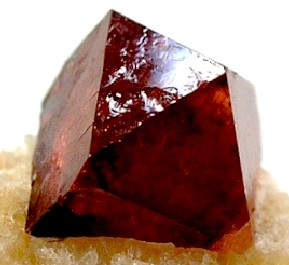
Photo: Rob Lavinsky - Jacinth Zircon
Humoral Property: "of a cold nature"2
Description: "Jacinth [*The Stone, not the Herb] strengthens the Heart, being either beaten into Powder, and taken inwardly or only worn in a Ring."3
"Hyacinthus, Offic. The Hyacinth. This is so called, from its Resemblence to the Plant of that Name, in its yellowish Colour, of which there being several Degrees, the different Kinds of it are taken from thence: Some are of the Colour of red Lead, or bilious Blood, some of Saffron, some of yellow Amber, which are the least esteem'd. Hyacinths are distinguished into Oriental, which are brought from the East-Indies; and Occidental, which comes from Silesia [now Germany], Bohemia, Auvergne in France, and other Places... Many superstitious virtues have been ascribed to this Stone. They said it was of a cold Nature; that it strengthens the Heart, is gently astringent [draws from the flesh together in wounds], and procures Sleep"4
1 "158. John Tweedy's Bill for Medicines. November 8, 1743". Privateering and Piracy in the Colonial Period Illustrative Documents, John Franklin Jameson, ed., p. 460; 2 Jean de Renou, A Medicinal Dispensatory, 1657, p. 416; 3 Nicholas Culpeper, Pharmacopœia Londinesis, 1720, p. 49; 4 Robert James, Pharmacopoeia Universalis, 1747, p. 561-2
Lapis Calaminaris (Calamine)
Listed in: Moyle: Lapis Calaminar1, Tweedy: Lap. Calamin. praept.2
Category: Simple - Mineral
Humoral Property: dry3; cooling and drying4
Photo: Nkansah Rexford - Mineral Calamine
Description: "Lapis Calaminaris, Calamine. This Fossile [mineral] is found in many places.... It is used as a great Dryer and Absorbent in outward Applications, for it is scarce at all used inwardly. It is used in Cerates [hard ointments] and Plasters, as an Incarner [agent for growing flesh in a wound] and Cleanser of Ulcers; as also in Collyriums [eye washes] against Inflammations of the Eyes."5
"Calminaris Lapis, Offic. Calaminar Stone. ...Lapis Calaminaris, or Calamine of the [apothecary] Shops, is a fossil Substance, of a middle Consistence between Stone and Earth, of different Colours, such as a pale Colour inclining to white, yellowish, and a blackish red. This last is full of small ferruginous [rust colored] Globules, like Grains of Pepper, and mark'd with white Veins, and is found in great Quantities about Bourges near Saumur, in Anjoy, in France, and many Parts of England. The others are dug in Germany, near Aix la Chapelle; and all Kinds of it seem to partake of au Iron-Ore, because the greatest Part is attracted by the Load-stone. ...It is now prescribed, by some Physicians, to dry running Ulcers, to heal the excoriated Parts [places where the skin has been scraped off] of Children, either in a fine Powder by it-self, or mix'd with Ointments. The Lapis Calaminaris is much used in cooling, and drying Cerates; and is, in Powder, frequently sprinkled upon Sores and Ulcers, with a View of drying them, and disposing them to cicatrize [heal over with a scar]. I have been told, that the Surgeons have lately observed, that Lapis Calaminaris, reduced to a very fine Powder, operates as an Escharotic [mild caustic]; whereas in a more gross Powder it acts as a Dryer."6
1 John Moyle, The Sea Chirurgeon, 1693, p. 33; 2 "158. John Tweedy's Bill for Medicines. November 8, 1743". Privateering and Piracy in the Colonial Period Illustrative Documents, John Franklin Jameson, ed., p. 460; 3 John Quincy, Pharmacopoeia Officinalis & Extemporanea, 1719, p. 108; 4 Robert James, Pharmacopoeia Universalis, 1747, p. 551; 5 Quincy, p. 108; 6 James, p. 551
Lapis Hibernicus (Irish Slate)
Listed in: Moyle: Lapis Hybernicus prepa.1
Category: Simple - Mineral

Photo: Humphry Bolton
Slate Quarry Near Inchanaglogh, Co. Kilkenny
Description: "Lapid Hibernicus, Irish Slate. It is black, softish, flakey Stone, not much unlike what is call'd Coal-stone, that come into the [apothecary] Shops under this Name. Its Efficacy in Medicines does not appear to have travell'd far; and in our own Country it seems only in the account of the common People, who have a mighty Opinion, from Custom, and its frequent use in such Cases, of its healing Virtues in Bruises and inward Injuries. Its Substance is somewhat soft and fatish, which may probaby give some assistance in such Cases; bit 'tis rare to meet with it in the Prescription of Physicians."2
"Lapis Hibernicus, Offic. Irish Slate. It is a fossile [mineral] Stone, of a black Colour, somewhat inclining to an Azure, and of an earthy Taste; and found in Mines, as well in England, as in Ireland. This Stone is frequently used in Contusions; for it resolves coagulated Blood: Some say it is effectual in quartan Fevers; but it is much us'd in all Kinds of Hæmorrhages, uterine Fluxes, and Spitting of Blood."3
1 John Moyle, The Sea Chirurgeon, 1693, p. 33; 2 John Quincy, Pharmacopoeia Officinalis & Extemporanea, 1719, p. 97; 3 Robert James, Pharmacopoeia Universalis, 1747, p. 565
Lithargyrum (Lead Oxide)
Listed in: Woodall:Lithargyrum1, Tweedy:Lith. Aur. praept.2
Category: Simple - Mineral
Humoral Property: cool [refrigerates]3; "refrigerate"4
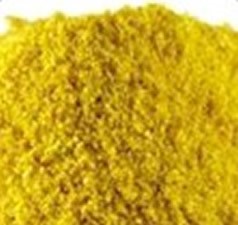
Litharge (Lead sub Oxide)
Description: "Lithargyrus, or Lithargyrum auri & argenti, & plumbi, Litharge either of gold silver, or leade, doe all refrigerate, binde, represse, stop, fill up hollow places, cleanse, induce a siccatrize or little scarre: and prevaile against the gallings of the thighes. The litharge of golde, of silver and of leade, are all but one thing, though they are of severall names, colour and differences of operations, by reason of their different preparations [as opposed to actually coming from the metals they are named for], they are as Minium is, all the sonnes of Saturne [in alchemy, lead is associated with the god Saturn], and are even lead & no other thing."5
"Plumbi Oxydum Semibitreum. ...Litharge, Lithargyrum. ...This is procured by means of heat, from melting red lead [minium] and allowing it to cool, during which process it combines with carbonic acid, and forms the yellow protoxide of lead, which is litharge. It is in scales or flakes of glassy luster"6.
1 John Woodall, the surgions mate, 1617, p. 113; 2 "158. John Tweedy's Bill for Medicines. November 8, 1743". Privateering and Piracy in the Colonial Period Illustrative Documents, John Franklin Jameson, ed., p. 460; 3 Jean de Renou, A Medicinal Dispensatory, 1657, p. 438; 4,5 Woodall, p. 113; 6 James Rennie, A New Supplement to the Pharmacopœpias of London, Edinburgh, Dublin and Paris, Baldwin and Cradock, 1833, p. 332-3
Oleum Petreoli (Petroleum)
Listed in: Woodall-Chest: Oleum Petreoli1
Category: Simple - Mineral
Humoral Property: "hot and dry"2
Photo: Wiki User PetrS
Natural Oil Seep at Korna, Slovakia
Description: "Oyle of Peter ...by the tenuity [thinness] of the essence thereof doth penetrate and digest [eliminate] all excrementall matter, it is used with profit for the falling sicknes [epilepsy], palsie, giddinesse of the head, and is good for many other griefes arising from cold causes."3
"Petreol is the work and effect of natures hand, not of the Apothecaries; for he onely collects it, or buys, keeps and uses it when collected: for Nature confects it in the bowels of the Earth, and it eructates [belches] out of the clefts of Rocks; whence it is calle Petreol, or Rock-Oyl. It is to be had in those Regions where Bitumen is, whereunto it is related: for Bitumen is either dense or liquid; the dense, is as it were the fatness of the earth, which swims upon the water, and by agitation of the winds, is cast upon the shore, and there concretes, and becomes tenacious and dense."4
1,2,3 John Woodall, the surgions mate, 1617, p. 73; 4 Jean de Renou, A Medicinal Dispensatory, 1657, p. 673
Sal Gemma (Rock Salt)
Listed in: Woodall: Sal Gemma1
Category: Simple - Mineral
Humoral Property: "hot and dry, some affirme in the second degree, some in the third"2
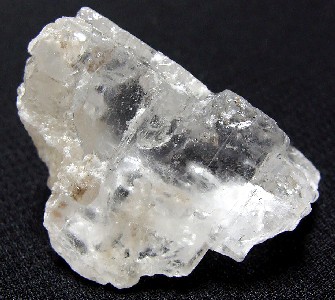
Photo: Wiki user aomorikuma - Rock Salt
Description: Sal Gemma "is the salt that groweth concrete, hard and pure in the bowels of the earth, such is the Sal Gemm, and this last is held best [better than naturally dried sea salt or decocted salt from natural spings according to Woodall], both in meate [meat is used as a generic term for food] and medicine, it is in colour like the Christall transparent, and groweth in great quantityin Polonia, neere the City of Craconia [modern Krakow, Poland]."3
Woodall notes that people who do not eat salted food (or poorly salted food) "breedeth diseases, as the falling sicknesse [epilpesy] and other great greefes: for, saith he, salt mightily helpeth digestion, and conccotion, and likewise comforteth all the faculties of mans body, it is the Balsam of the earthe, whereby mens bodies are preserved alive... Josephus Quercitanus [16th century French physician Joseph Duchesne] affirmeth salt to be a spur to all medicines, both outward and inward, with which it is mixed, stirring them up and quickning them, the better to performe their offices, and the longer to retaine their vertues, by preserving them from outward putrefaction of the ayre."4
1 John Woodall, the surgions mate, 1617, p. 46; 2 Woodall, p. 274; 3 Woodall, p. 272; 4 Woodall, p. 274
Sal Nitri (Saltpeter)
Listed in: Woodall-Chest: Sal Nitri1
Category: Simple - Mineral
Humoral Property: "it is either hot or coole"2
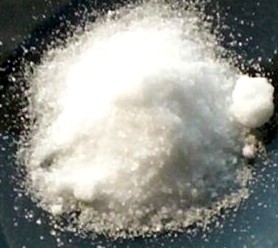
Saltpeter - Potassium Nitrate
Description: "Sal Nitri Is the Christilline salt purified from grosse Salt-peeter known to be pure by that it doth containe no common salt therein, being also wholly combustible of temperament... This Salt niter is either animall or vegitable, or growing in mines, and it is every where, for every creature living may bee sayd to have a part thereof: man and beast, I am sure hath a great part of it. It is a most medicinable subject as any is in the world, and no man can live without it, for our bloud and urine hath it in it, yea, and our very excrements are mixed therewith, it is also in caves, in mountains and plaines and where not?
...I say, Sal niter in the Surgeons chest is a worthy medicine, and the purer it is, the better it is for all uses: Touching the inward uses thereof, it is good against Hemoragia [hemorhages], or bleeding of a veine, whether it bee by the
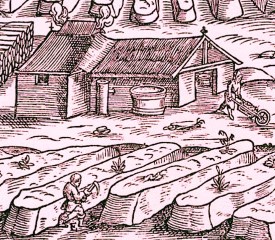
Saltpeter Refinery, From Monumenta Pulveris Pyrii,
by Oscar Guttmann, p. 89 (1580)
nose, or any inward vaine of the body, taken {1 dram} dissolved in Plantane or faire water [clean, pure water].
In the Callenture [tropical fever] it is approoved good to coole the boyling of the bloud taken as aforesaid, the dose for a neede, if the heat bee great, may bee given every foure houres, or the party may have a barley water rather made, wherein two dragmes [drams] or more may be dissolved to drinke at wil, it will not offend him, onely if hee take too great a dose at once it may cause him to vomit, but it will not hurt him. It is the best thing I doe know for the furring of the mouth and the throat in fevors, the place gently washed therewith dissolved in water, it presently bringeth away all the whitenesse & furring, without offence. It is not ungratefull of taste: but so soone as you have taken such furring away, I advise that you have readie some gentle sanative [healing] lotion to inject, to take away the acrimonie thereof, for it is abstergent [detergent/cleansing], and yet without violence or danger, you may use therefore the ordinary lotion one part, faire water [clean, pure water] two parts, and so inject to cleanse the mouth after the use thereof."3
1,2 John Woodall, the surgions mate, 1617, p. 286; 3 John Woodall, the surgions mate, 1617, p. 286-8
Spodium (Putty)
Listed in: Woodall: Spodium1
Category: Simple - Mineral
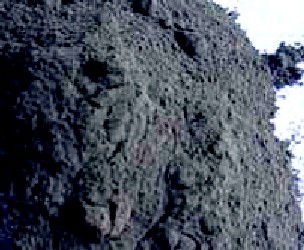
Spodium
Description: "Spodium an astringent [tissue contracting] simple, is cordiall [good for the heart], and good for fainting or swounding, inflammations of the stomack, trembling, melancholy, and other affections arising thence."2
"Spodium Græcorum, Nihil Grysenis, Offic. Putty. This is the Ashes, or rather the metallic Flour, collected in the Furnaces and Shops of Copper Smiths, and differs from the Pompholyx in being more heavy, and not so pure. This is never given inwardly, but was sometimes applied externally."3
"Nothing is more frequently inculcated [taught] in Pharmacopolies, and nothing less understood, then Spodium...
The Grecian Spodium, which is indeed the sole Spodium, is found in brass furnaces with Pompholix, with which it hath much affinity: and it is then made, when micant [twinkling] sparks ascend from the Metal while it is cocting [boiling]: and because of their gravity delabe [slide] down again upon the pavement; which as they refrigerate [cool off], mix themselves with filth: and hence this concreated heap of sparkes is inquinated [polluted], which they call Græcian Spodium, which is of use onely in external affections."4
1,2 John Woodall, the surgions mate, 1617, p. 110; 3 Robert James, Pharmacopoeia Universalis, 1747, p. 590; 4 Jean de Renou, A Medicinal Dispensatory, 1657, p. 434-5
Stibium (Antimony)
Listed in: Woodall-Chest: Stibium1, Tweedy: Antimo. Crud.2
Category: Simple - Mineral
Humoral Property: dry3
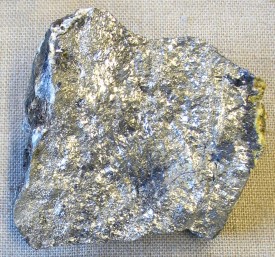
Photo: Aram Dulyan - Stibium aka Antimony
Description:"Antimonium, seu Stibium, used in due time and place, produceth very good effects, wrestling well with many kindes of strong diseases, commonly it is given in a Tertian [malarial fever], as also to the troubled with collicke paine, it purgeth upward [vomiting] and downeward [laxative] forcibly, and causeth sweat, it is a good medicine given with carefull respect: it killeth many by the violence thereof unadvisedly administred, I lament to call to minde what fearefull accidents I have seene follow the use thereof, I advise the Surgeons mate to administer it with great care, the dose is five graines, best taken by infusion [it is infused by soaking it in a liquid for the patient to drink]. It cureth fevors, is good against pestilentiall fevors in their beginning. For it cureth such at once taking, and in any other fevours it may be given, the body being strong."4
"Antimonium; Antimony. This is a heavy metalline Substance, compacted, as it were, of long shining Needles. It is in many places in Europe; but what is generally in the Shops, is not the true mineral Antimony, but has been melted, and cast into pyramidal and conical Forms. Its metalline Parts approach near to the nature of Lead; but those Virtues which give it such a large share in Medicine, altogether arise from its sulphureous Parts."5
1 John Woodall, the surgions mate, 1617, p. 111; 2 "158. John Tweedy's Bill for Medicines. November 8, 1743". Privateering and Piracy in the Colonial Period Illustrative Documents, John Franklin Jameson, ed., p. 459; 3 Thomas Brugis, The Marrow of Physick, 1669, p. 170; 4 Woodall, p. 111-2; 8 John Quincy, Pharmacopoeia Officinalis & Extemporanea, 1719, p. 483
Succinum (Amber)
Listed in: Woodall: Succinum1
Category: Simple - Mineral
Humoral Property: hot2; hot and dry3
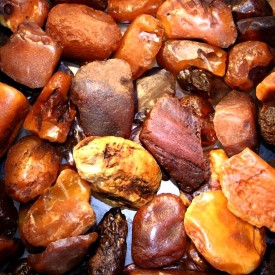
Photo: Wiki User Lanzi - Ubpolished Amber
Description: "Ambra citrine sen succinum... prevalent against the white fluxe of the wombe [vaginal discharge], fluxe [flows] of bloud running of the kidneyes, distillations of the head, stopping of the matrix [womb], monethly termes [menstruation], difficulty of urine, being powdered and drunke, helpeth immoderate cough, and strengthneth the intestines, and is good to be cast on coales to receive the fume thereof, to comfort the Arsegut fallen [prolapsed anus], as also rofume [scent the air of - thought to fix disease-causing air] a ship or house in time of infectious aires, as the plague, or when generall fluxes are to be feared."4
"Succinum, Amber. This is a bituminous Juice or Resin, which from a Fluor [flowing] grows hard and brittle; for that is has been in a State of Fluidity, is manifest from the several Parcels of it, which have inclosed Scraws [pieces of grass] and Insects of various kinds: The whitest and most transparent is accounted best. It is of no great use in Medicine per se, as its Texture seems too compact to open and yield to natural Elaborations [compositions]; tho some have a great Opinions of it as a Balsamick, and give it in Gonorrhea's particularly: and it is also an Ingredient in the Gascoign's Powder. But certain it is, that what the Art of Pharmacy extorts from it is of wonderful Efficacy, especially in nervous Cases."5
"Amber (viz. yellow Amber) ...prevails against most diseases of the head. It helps violent Coughs, helps Consumption of the Lungs [tuberculosis], spitting of blood, the Whites [vaginal discharge] in Women. It helps such Women that are out of measure unwieldy in their going with Child, it stops bleeding at the Nose, helps difficulty of Urine. You may take ten or twenty grains at a time."6
1 John Woodall, the surgions mate, 1617, p. 108; 2 Thomas Brugis, The Marrow of Physick, 1669, p. 169; 3 Nicholas Culpeper, Pharmacopœia Londinesis, 1720, p. 48 & Woodall, p. 108; 4 Woodall, p. 108;5 John Quincy, Pharmacopoeia Officinalis & Extemporanea, 1719, p. 94; 6 Nicholas Culpeper, p. 48
Sulphur
Listed in: Woodall: Sulphur1
Category: Simple - Mineral
Humoral Property: hot and dry2; hot [califies]3; "hot"4
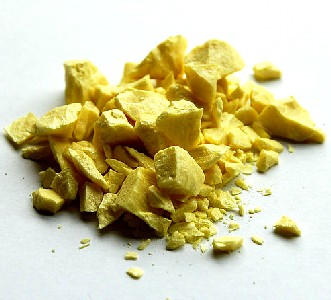
Photo: Ben Mills - Sulfur
Description: "Sulphur or Brimstone is ...concocting [combining] & resolving [removing], it profitteth the asthmaticall, cough, collicke, griefe, and resolution [elimination of the abnormal condition] of the members: taketh away itch, breaking out of all the body: cureth tetters or ring-worms, and the scurffe [flaking of the skin], and cureth rheumes [running nose and eyes] and distillations."5
"Sulphur. The Sulphur of the [apothecary] Shops... because used in all expiatory [atoning] or other sacred Rites, is a mineral, concreted Juice, solid, dry, friable [crumbles easily], fusible by Fire, and very easily inflammable. The Flame it emits is blue, and the Smell of burning Sulphur is strong, subtile, acid, and very prejudicial to the Lungs. Sulphur is of various Kinds; it is in the first Place divided into... native Sulphur, which has never been exposed to the Fire; and... factitious Sulphur, prepared by Fire. It is either of a yellow, yellowish Ash, or light Colour, and either pure or impure in Substance. Native Sulphur is of two Kinds; one pellucid [translucently clear], and shining like gold, and either of a citrine [deep yellow] or greenish Colour. This is found about the Gold Mines in Peru in Switzerland, and many other Places. The other opake [opaque], found either in hard, solid, shining, greenish, or yellow Lumps, or in a Form of a clayish Glebe [piece of earth], of a light Ash Colour, or yellow. This Kind is dug near ll the burning Mountains, near some
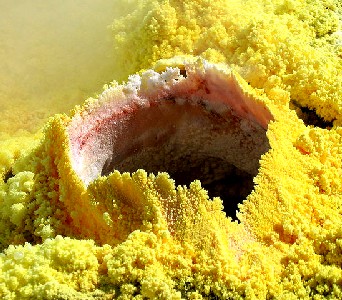
Photo: Wiki User Brisk G - Sulfur From Volcanic Fumerole
sulphureous Springs, and in several other Places of Europe and America. Factitious Sulphur is prepared in different Manners. In some Places it is obtain'd by boiling of Water; and at Buda in Hungary, according to [German mineralogist George] Agricola, it is evaporated with the Water of the Mineral Springs, and concretes in the Covering or Dome of these Fountains, like the Flower of Brimstone, and is gather'd from thence, once every Year, with great Care. It is, also extracted from a Sort of Ash-colour'd argillaceous [clay] Earth....
The internal Use of Sulphur is recommended by Physicians for Diseases of the Lungs, or which it is, by way of Eminence, termed the Balsam; because it promotes Expectoration [coughing up mucus from the lungs], and clears and strengthens that Organ, and is therefore very beneficial in a Phthisis [tuberculosis of the lungs], Asthma, and Catarrh [excessive build up of mucus in the nose and throat]. It has in all Ages been a famous Medicine in cutaneous [skin] Diseases, Scabs, and Psoræ [the itch], used inwardly, or outwardly. Externally apply'd it discusses [disperses] hard Tumors, ripens and digests [removes] Buboes [veneral swellings in the groin]; but no Medicine prepared with Sulphur is thought to be agreeable to Women with Child, because it is subject to cause Abortion. Inwardly taken as a laxative, and promotes insensible Perspiration, as may be perceived by the sulphureous Smell of such Persons as have taken it, and by the brownish or black Colour which it gives to the Gold or Silver they carry about them. ...by its native, mild, soft, and oily Qualities, it readily cures small Ulcers in the Lungs and Skin. Though Sulphur may be given inwardly, even in a gross Powder, yet it is seldom order'd without some Preparation [compounding with other medicinals]."6
1 John Woodall, the surgions mate, 1617, p. 112; 2 Thomas Brugis, The Marrow of Physick, 1669, p. 171; 3 Jean de Renou, A Medicinal Dispensatory, 1657, p. 405; 4,5 Woodall, p. 112; 6 Robert James, Pharmacopoeia Universalis, 1747, p. 592-3
Terra Sigilata (Sealed Earth or Earth of Lemnos)
Listed in: Woodall-Chest: Terra Sigilata1
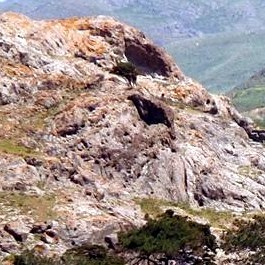
Photo: Michael Clark - Earth of Lemnos
Category: Simple - Mineral
Humoral Property: "drying"2
Description: Terra Sigilata basically means 'sealed earth" which was sealed by being "stamped [or sealed] with the head of Artemis"3. Woodall suggests the Terra Sigilata (along with a variety of other medicinal earths) are used for "the better cure of these wounds in the braine desiccation [drying] and siccatrization [cicatrizing - healing over with a scar] in due time"4. Woodall also advises using it as an astringent medicine on "wounds in the veines and Arteries, [which] bring with them commonly a fluxe [flow] of bloud, which to stay [stop] is a speciall businesse"5.
"Terra Sigillata, or Seal'd Earth, is a Kind of white Bole, [according to French physician Pierre] Pomet. Sometimes a little reddish, that is moisten'd with Water, and afterwards form'd into like Cakes half found,
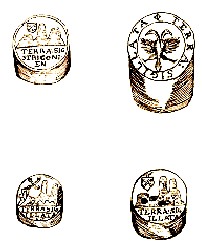
Artist: Olaus Wormius
Some Terra Sigilata (Sealed) Containers
Courtesy of Wellcome Images
of the Bigness of one's Thumb, upon which is stampt several Characters. The Variety of Figures, Colours, and different Seals that are found upon the Terra Sigillata, makes me think that every one makes them to his Fancy; and that it is nothing but a fat astringent [drawing] Earth, that is more or less colour'd, and reduc'd into such Cakes as are brought us. ...the Earth that is most us'd and esteem'd, is that which is in little reddish Cakes, the least sandy or gravelly, and the most astringent [drawing] that you can get. It is much used in Medicine because of its astringent [drawing together] Quality. It is also an Ingredient in Venice Treacle, and needs no other Preparations than to have the above-described Qualifications."6
"Terra Sigillata, Seal'd Earth. These [Terra Sigillata, Terra Lemnia (Earth of Lemnos) and Terra Samia (Earth of Samos)] are very much alike in their Medicinal Virtues, and are used in the same Intention of drying and astringing; but they are neither so good as the two former [Terra Lemnia – Earth of Lemnos & Terra Samia – Earth of Samos], and therefore seldom are to be met with in Prescription."7
1 John Woodall, the surgions mate, 1639, Insert pullout page before p. 27; 2 John Quincy, Pharmacopoeia Officinalis & Extemporanea, 1719, p. 107 & John Woodall, the surgions mate, 1617, p. 130;; 3 "Terra sigilata - Medicinal earth", wikipedia.com, gathereed 8/18/14; 4 Woodall, 1617. p. 130; 5 Woodall, 1617. p. 132; 6 Pierre Pomet, A Compleat History of Druggs, 3rd Ed., p. 415; 7 Quincy, p. 107
Tutia (Zinc Oxide)
Listed in: Woodall-Chest: Tutia1, Moyle: Lapis Tutiæ prepar.2, Tweedy: Lap. Tutiae praept.3
Category: Simple - Mineral
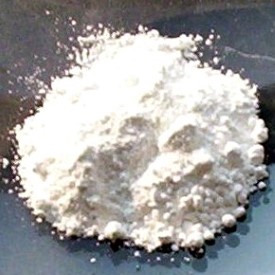
Photo: Walkerama - Zinc Oxide
Humoral Property: dry4; "a gentle drier"5
Description: "Tutia is ...good against the distillations of the eyes, astringent [draws flesh together], cooling, cleansing, stopping, and filling up. It is the scumme of brasse in boiling."6
"Tutiæ, Tutty. It flies off from Brass in the Furnace, as the Flakes of Iron do, when just taken out of the Fire. It is extremely hard, almost as Glass; and loses nothing in Levigation [making it into powder]."7
"Tutie, is the excellentest of all medicines, which dry without modacrity [harshness?]; if wash'd, [it is] fit for cancrous ulcers, in Collyria's [medicinal lotions applied to the eyes] for fluxions [flows from] and inflammations of the eyes."8
1 John Woodall, the surgions mate, 1617, p. 114; 2 John Moyle, The Sea Chirurgeon, 1693, p. 33; 3 "158. John Tweedy's Bill for Medicines. November 8, 1743". Privateering and Piracy in the Colonial Period Illustrative Documents, John Franklin Jameson, ed., p. 460; 4 Thomas Brugis, The Marrow of Physick, 1669, p. 171; 5,6 Woodall, p. 114; 7 John Quincy, Pharmacopoeia Officinalis & Extemporanea, 1719, p. 108; 8 Brugis, p. 171
Vitriolum (Blue Vitriol)
Listed in: Woodall: Vitriolum1, Moyle: Vitriol Romanum 2, Tweedy:Vitriol. Roman.3
Category: Simple - Mineral
Humoral Property: "hot ...and drie"4
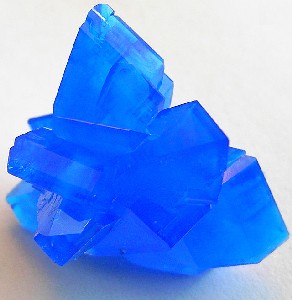
Photo: Stephan B.
Blue Vitriol (Copper Sulfate or Chalcanthite)
Description: "Vitriolum sen Calcanthum, or Coperas, is ...astringent [draws flesh together]... killeth the wormes of the belly, helpeth against poyson, keepeth the flesh moyst and from putritude [putrifying], consumeth [destroys], contracteth and purgeth ulcers."5
“Vitriolum, Vitriol. There are six sorts of this salt vendible amongst us, viz. Hungarian, Dantzick, Roman or Cyprus, English and German, and likewise White Vitriol. It is said these are all compos’d of an acid Salt and a sulphurous Earth; but it is most certain, that there is a proportion of Metal in them… In Colour, the Hungarian and Dantzick are Green; but the first is the deeper: the Roman or Cyprus is Blue; the English is yet a paler green than either."6
"Blue Vitriol is dry to the Touch, and concreted into blue Crystals, like Sapphires, of a Rhomboidal Figure, flattened, and consisting of ten Sides. It is brought from several Places, especially from Hungary and Cyprus; and its beautiful blue Colour is owing to the Copper which it contains. The Taste of it is very acrid and austere."7
1 John Woodall, the surgions mate, 1617, p. 112; 2 John Moyle, The Sea Chirurgeon, 1693, p. 32; 3 "158. John Tweedy's Bill for Medicines. November 8, 1743". Privateering and Piracy in the Colonial Period Illustrative Documents, John Franklin Jameson, ed., p. 460; 4 Thomas Brugis, The Marrow of Physick, 1669, p. 146; 5,6 Woodall, p. 120; 7 John Quincy, Pharmacopoeia Officinalis & Extemporanea, 1719, p. 285-6;7 Robert James, Pharmacopoeia Universalis, 1747, p. 598
Vitriolum Album (White Vitriol or Zinc Sulfate)
Listed in: Woodall: Vitriolum Album1, Moyle: Vitriol Album2
Category: Simple - Mineral
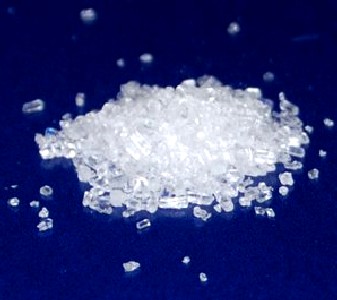
Photo: Wiki User Minerallad - White Vitriol (Zinc Sulfate)
Description: "White Coperas is easilie made of other kinds of coperas, it is generallie called Vitriol, or white Vitriol in English, as if it were worthy a higher or more particular name, or respect, when in truth, as white waxe is made of yellow wax, by the bleaking [exposing] it in the aire, and washing it oft, so is white Coperas made of greene Coperas, and is thereby, in my conceit, the weaker...
The cheefe uses I have made thereof, is for Collyriums or Lotions for the infirmities of the eies, namelie, against itchings, akings, smartings, defluctions [defluxions - flows], opthalmia's of the eies, wherein since I finde it to exceede either Lapis Calaminaris, Tutia, or Camphire."3
“Vitriolum, Vitriol. There are six sorts of this salt vendible amongst us, viz. Hungarian, Dantzick, Roman or Cyprus, English and German, and likewise White Vitriol. It is said these are all compos’d of an acid Salt and a sulphurous Earth; but it is most certain, that there is a proportion of Metal in them... The White takes its name from its Colour. ...Dr [Edward] Brown [17th/18th century English physician] in his Travales, tells us, that at Friburg in Germany they take the Ore, out of which Brimstone has been melted, and burn it again in open Air; then putting it into a large Vat, they pour Water upon it, so as to imbibe and drink in the Vitriol: this Water is afterwards boil’d to a sufficient height, and let out into Coolers; where Sticks are set in it, as in the making of Sugar-Candy: the purest chrystalliz’d Vitriol sticks to the Wood, and the rest to the Sides and Bottom."4
"White Vitriol is brought from Germany, made up in Loaves, like Sugar, and is of a sweetish astringent taste."5
1 John Woodall, the surgions mate, 1617, p. 112; 2 John Moyle, The Sea Chirurgeon, 1693, p. 32; 3 Woodall, p. 283-4; 4 John Quincy, Pharmacopoeia Officinalis & Extemporanea, 1719, p. 285-6; 7 Robert James, Pharmacopoeia Universalis, 1747, p. 598

